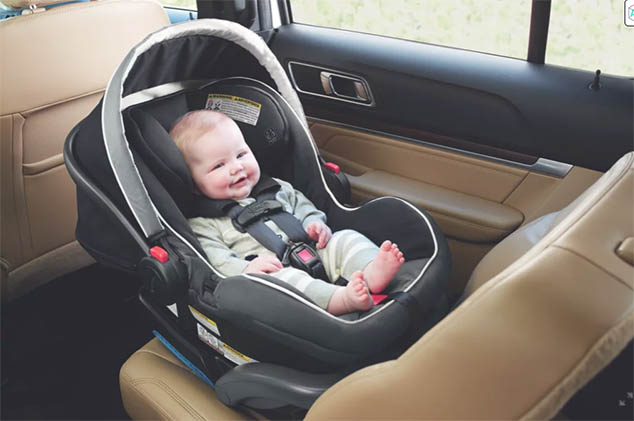
Is Car Seat Really Important
New parents are always willing to go the extra mile to ensure their precious little ones have their utmost safety, comfort, and care. While the virtual world behind a screen with an ocean of information is always at the rescue of new or expectant parents, the importance of a car seat is often unclear.
Is a car seat really important- this is one of the most common questions that pop up. And the answer is yes. The necessity of car seats is often underrated. The body proportions of a child are different than that of an adult. Correspondingly, children are not well-suited for use with standard restraints like seat belts in the case of a collision.
A protective seat, designed solely for children, which is adequately comfortable, sturdy high, shock-absorbing backrest should be used for infants and children until they are 12. Children’s car seats come in a variety of sizes to accommodate their growth as they develop.
Importance of Car Seat
Researchers conclude that motor vehicle crashes are the second leading cause of death in children from 1 to 14; second to only infectious diseases. Continued reluctant submissiveness to traffic safety measures worldwide is an issue yet to be addressed. The usage of car seats has been known to reduce the cause of morbidity and mobility among children by 80%. Yet unawareness of child passenger safety among parents is very common. Parents are often not clear about the necessity and proper usage of car seats. It is important for parents to consciously use child safety seats to protect children again potentially fatal crash forces.
Car seats are specially designed considering the delicacy of young children and made out of high shock-absorbing, breathable material. These work much better than regular seat belts, ensuring your child’s safety and comfort.
Is a Car Seat Necessary for a Newborn?
The first trip from the hospital to home regardless of the distance should be the safest and most caution-induced trip of your child’s life and that is why a newborn does require a car seat. Ideally, expectant mothers should get a car seat a few weeks before their due date. This gives parents a sense of preparedness and allows time ahead to troubleshoot any issue that may occur with the installation.
Parents may often think an infant car seat is unnecessary and they can shift directly to a convertible. However, infant car seats are forward facing and can be reclined at an angle which is very comfortable for a newborn. Infant car seats also come with a lot of different indicators, which work together to make sure the baby is safe and sound.
Although convertibles can act as a replacement, they are also designed for toddlers, who have different body mass and weight than that of an infant. Moreover, most convertibles allow children of about 1 year and older. In any case, most states do not allow children less than a year to be on a convertible.
Do Car Seats Really Make a Difference?
Using a car seat is the best way to protect your child, and there are no other alternatives. Car crashes are one of the leading causes of death and injury among children worldwide. Not using a car seat only magnifies the effects and chances of injuries. By law, every state in the US requires parents to use a car seat that is appropriate for their child’s height weight, and age.
Proper Uses and Common Misuses of Child Safety Seats
Car seats employ maximum efficiency only when they are used correctly. The entire process of choosing a car seat installing and using it is a little complicated. Therefore it is commonly misused. The points below outline some of the important features of car seats and their uses-
· Installing a rear-facing car seat
Most car seats are rear-facing. But a rear-facing car seat should never be installed in front of an airbag. If any unfortunate event occurs that deploys the usage of an airbag, it directly hit the rear-facing car seat of the child and causes fatal injury. However, children are much safer in a rear-facing car seat until they exceed 20 pounds or after their first birthday.
Proper installation of the car seat is very important. Far too often the car seat is loosely attached to the car. The seat is supposed to be firmly planted and its movement should be restricted to 1 inch from all sides.
For comfortable and uninterrupted breathing, babies are supposed to be placed at a 45° angle on infant car seats. These car seats often come with a needle that works as an indication for the 45° angle.
Infant car seats have a handle for portability or a sun shield. Parents should have these down while traveling. Child car seats that have survived a crash should be discarded immediately, regardless of how fine they look. One car seat should not be used for more than 10 years.
· Aligning the requirements
Each seat comes with its own set of information for installation and height and weight requirements. Parents should use the seats accordingly; which is most appropriate and compatible with their vehicles and suits their child’s height and weight the best.
A convertible car seat can be used in both forward and rear-facing directions. And each side has a different mechanism for buckling up the seatbelt and a different weight limit. Parents must monitor the correct usage of seat belts and that the car seat is perfect for withholding their child’s weight.
· Tether straps
Tether straps add that extra padding of safety on car seats. These are generally available on newer models. These straps work on restricting the movement of the baby’s head, by connecting the seatbelt to an anchor.
Risk Factors for Child Passengers and the Importance of a Car Seat
Spines fully develop from the age of 3 to 5 years, and babies have their heads large compared to the rest of their bodies. This puts them at a greater risk of injury during any crash. Some of the risk factors and studies reflecting the importance of car seats are pointed blow-
Safety
If a baby is riding forward-facing during a crash event, the collision directly affects the spinal cord, which is ultimately fatal. Whereas, when a baby is riding rear-facing cradled in a car seat, the baby’s head neck and spine are well protected; especially in the event of a frontal crash, which is the most common type of crash.
Age
A study conducted using fatal crash data in 2020 reviews that 40% of children from 8-12 years old don’t use any sort of restraint. Moreover, the children who do use car seats, often upgrade to a new one sooner than they should. For example, sometimes parents allow children to stop using booster seats before the regular seat belt fits them properly. This puts the child at risk.
Location
Children in rural areas are at a higher risk of motor vehicle accidental death than compared to urban areas. This was revealed in a study conducted from combined data from 2015 to 2019. More studies indicate that parents from rural areas tend to use restraints like car seats incorrectly. The misuse of restraint in a rural area is 91%, than in urban areas, which is 83%.
Alcohol-impaired driving
This is a major threat to only child passengers but also to all road users. The reaction time of a person under influence of alcohol reduces significantly. This boosts the chances of unwanted travel events like crashes or collisions. However proper use of safety measures and restraints will always reduce the odds of any untoward event. Proper Usage of car seats and booster seats Researchers show that children riding in cars in a study in 2011 say that 46% of car seats and booster seats were not used properly and this, by default, reduces their effectiveness.
Reducing Risk Factors Using Car Seats
Car seats are found to have reduced the risk of an injury in a travel event by 71 to 82% in children. Booster seats reduce the risk of fatality by a good 45% in children 4-8 years old. Recent studies show the percentage might be higher for children from 7-8 years old.
FAQ
Why are car seats important?
Using an appropriate safety car seat is the best way to protect your child while traveling.
What are some of the must-haves of a car seat?
The most important features of a car seat are extra padding and material breathability for your child’s safety and comfort.
How efficient are car seats?
The National Highway Traffic Safety Administration says car seats reduce the risk of injury for infants by 71% and for toddlers by 54%.
Last Few Words
Poor compliance for safety in car seats remains to be an issue globally. As we thrive e towards a better tomorrow, car seats are a big investment in reducing traffic injuries and improving population health

Frank Matthew is an accomplished professional with a background in pediatrics, research, and writing. He began his career as a pediatrician and gained invaluable experience in caring for children, managing illnesses, and ensuring their overall wellbeing. After several years of practicing medicine, Frank shifted his focus to research and investigation in the fields of baby products, child safety, and child development. His passion for improving the lives of children through knowledge and understanding of these critical areas led him to become a leading expert in the field.
Today, Frank is a full-time author and blogger of the website Babyfifi.com, where he shares his expertise and insights with parents, caregivers, and professionals around the world. His extensive knowledge, combined with his exceptional writing skills, make him a sought-after resource for anyone seeking information on child development, parenting, and child safety. Frank’s dedication to improving the lives of children and their families is evident in everything he does, and his contributions to the field of pediatrics continue to make a significant impact.
